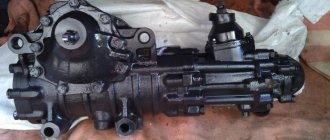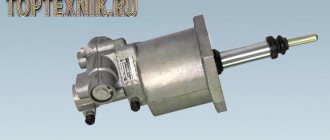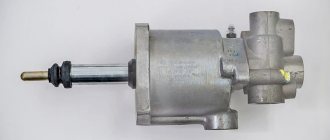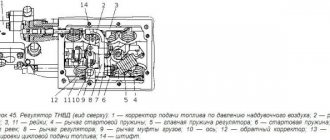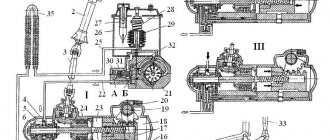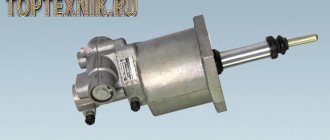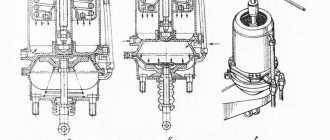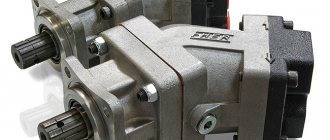- home
- Media center
- Articles
- How to pump power steering on a KAMAZ
Menu
- News
- Articles
- Video materials
- Photo materials
- Publication in the media
- 3D tour
09.06.2019
Power steering is a relatively new invention in modern mechanical engineering, compared to other auxiliary mechanisms. Therefore, today only the old automobile industry can be found without power steering. The unit was initially installed specifically on trucks to make it easier for truck drivers to handle difficult-to-control heavy loads. After this mechanism took root on tractors, hydraulics began to be updated on passenger cars. However, even today you can find old cars without enhanced hydraulics. Fifty years ago, public needs were placed above personal needs, so tractor-trailer drivers managed their cars easier at work than their personal vehicles. Let's take a closer look at what functions does the power steering perform?
- The primary function is to reduce driver labor costs. Freight transport operates in highly loaded areas, quarries, performs long journeys, and operates in difficult weather conditions. Having adequately functioning hydraulics allows you to cope with all the difficulties of the road. Since the main role is given to the operation of the drive wheels, the hydraulic system stabilizes the operation of the main mechanical unit, the steering rack, helping to overcome obstacles much easier.
- Overcoming stabilization dissonance - the moment when the wheels stop keeping up with the overall smoothness of the ride, becoming more “tight” and clumsy. Power steering allows you to drive the car more smoothly, without unnecessary sudden movements of the steering wheel.
- Road irregularities are felt smoother. In other words, there is little effect on the Kamaz’s rigid suspension. This effect, firstly, creates a feeling of smoothing the driver from the road, and secondly, it reduces the overall vibration of the mechanisms.
- Additional control of road stabilization. Of course, the driver must control the movement, but if the drive wheel gets into a hole, an unexpected sharp violation of the trajectory at high speed can lead to dire consequences. For trucks, this factor is aggravated by the weight of the tractor itself, trailer, cargo (sometimes even taking into account overload).
In other words, in addition to providing simpler control, the hydraulic system performs a number of additional functions that bring a lot of benefits to the driver while driving.
Removing air from the power steering system on a KamAZ (correct “bleeding the steering”)
When filling the KamAZ power steering system with oil or after troubleshooting, it is necessary to remove air from it (“bleed” the steering).
To do this you need:
- Raise the front axle so that the wheels do not touch the ground. Using a jack, place trestles under the beam on both sides. But under no circumstances start pumping with the wheels standing on the ground. Or disconnect the longitudinal link from the steering bipod.
- Remove the pump reservoir filler cap.
- Remove the rubber cap from the steering gear bypass valve and place a transparent elastic hose on the spherical head of the valve, the open end of which is lowered into a glass container with a capacity of at least 0.5 liters. The vessel should be filled with oil to half its volume.
- Unscrew the steering gear bypass valve ½……3/4 turn.
- Turn the steering wheel LEFT until it stops.
- Pour oil into the pump reservoir until the level stops decreasing.
- Start the engine and, while operating at minimum crankshaft speed, add oil to the pump reservoir, not allowing the level to drop until air bubbles stop emitting from the hose placed on the bypass valve.
- Close the bypass valve.
- Turn the steering wheel to the RIGHT until it stops and back to the LEFT position. Keeping the steering wheel in the left position, unscrew the bypass valve ½……3/4 turn and again watch for the release of air bubbles. After the bubbles stop, close the bypass valve.
- Repeat the previous operation at least two times. As a result, clean (without air) oil should come out of the bypass valve. If the release of air bubbles continues, repeat the operation 1-2 more times, while monitoring the oil level in the pump reservoir, maintaining it between the marks on the level indicator.
- Stop the engine.
- Remove the hose from the spherical head of the bypass valve and place the protective cap on it. Check the oil level in the pump reservoir again and, if necessary, add oil. Install the pump reservoir filler cap. If you disconnected the longitudinal steering rod, install it in place.
The process of removing air from the system is complete.
Problem solving
Getting rid of air in the system
Now we will take a closer look at several ways to remove air from the power steering. First of all, inspect the system for damage; if none are detected with the naked eye, we will change the search method. You need to ask a friend to help. car and ask your friend to move the steering wheel from side to side. Bubbles may have appeared on the rubber tubes or pipes. If you find such a place, then this part needs to be replaced with a new one.
If the reason lay in an open cap on the liquid tank, be sure to close it. After this, you can try to expel the air from the system yourself. Turn on your vehicle's engine and let it idle for about 5 minutes. After this, start turning the steering wheel to the right all the way, hold in this position for 10 seconds, then turn to the left and hold this position again.
After several such cycles of turning the steering wheel, the air should come out of the system. You can check this by looking at the technical fluid; there should be no foam in it.
Bleeding and adjustment of PGU and GUR on KamAZ trucks
KamAZ PGU is a device designed to reduce the level of pressure exerted by the driver on the clutch pedal.
PGU - hydraulic power steering of a KamAZ pneumatic clutch type.
Design and principle of operation
The PGU device includes:
- spherical type nut;
- lock nut;
- a piston pusher that deactivates the clutch system;
- a cover that protects against damage;
- piston;
- complex type seal;
- bypass and inlet valve;
- cork;
- fuel fluid supply;
- system for compressing air flow.
The diagram also includes the following elements:
- spring mechanism;
- gearbox;
- diaphragm seats.
The operating principle of the PSU is as follows:
- The driver presses the clutch pedal.
- Under the pressure of the fuel fluid, the rod and piston part of the mechanism are activated.
- Movement occurs until the intake valve opens.
- The air flow moves in the direction of the pneumatic piston.
- The fork is retracted and the clutch system is disengaged.
Bleeding and adjustment
In order to adjust the CCGT, it is necessary:
- Adjust the pedal free play. Lower the pedal until the master cylinder starts to operate. After this, debugging is done using an eccentric finger. The gap between the piston part and the pusher should not exceed 1.2 cm. At the end of the procedure, you need to tighten the castle-type nut tightly.
- Adjust the clutch free play. Move the fork handle, remove the spring mechanism and perform debugging.
Procedure for pumping:
- Clean the rubber protective cap of the bypass valve.
- Place a rubber hose onto the valve.
- Place one end into a glass container with working fluid.
- Press the pedal jerkily 3 times, and the fourth time, while holding the pedal, loosen the bypass valve.
- As soon as the release of air bubbles from the liquid stops, you need to close the bypass valve and remove the hose.
Disassembly and repair
Repair of a CCGT unit involves its disassembly. To disassemble the mechanism with your own hands, you need to:
- Place the pneumatic power steering in a vice and clamp the rear housing.
- Unscrew the bolts and remove the air supply cover.
- Remove the amplifier valve from the front housing.
- Remove the spring and diaphragm.
- Pull out the thrust ring and piston part.
- Unscrew the mounting breather and remove the cover from the seal.
- Pull out the retaining ring.
- Remove the seats and washer.
- Remove the cuff.
- Installation and assembly of the KamAZ PGU is performed in the reverse order.
Possible malfunctions of the PSU:
- The drive is jammed. In this case, it is recommended to flush all hydraulic system elements and change the oil.
- The clutch is lagging. Use higher quality fuel fluid (for example, meeting Euro-5 standards). If this does not help, replace the piston seal.
- The clutch hisses and there is no boost. Inspect the intake valve and replace if necessary. It is also recommended to inspect the cuffs and the follower piston ring.
History and demand
The history of the brand began much earlier than 1977, which appears in many sources. The main character was Nikolaus August Otto, who founded the world's first company specializing in the production of engines in 1864. Already in 1890, a thresher was invented. 4 years later, the first Deutz tractor with a 26 hp gasoline engine was released. In 1927, the first diesel tractor Deutz MTN222 was produced, which in fact became the beginning of mass production of standard and now familiar tractors.
Since 1936, small agricultural enterprises have already begun to use mechanization and its face - the Deutz F1V 414, with a power of 11 hp.
In 1937 Klöckner was acquired, which became Klöckner-Humboldt-Deutz or simply KHD. This company becomes the largest conglomerate of the Reich. At that time, KHD worked in all areas related to engine production.
Since 1949, the production of tractors with a diesel engine and air cooling Deutz F1514 and F2514 has been launched. Already in 1955, the 100 thousandth copy was produced.
1961 – start of cooperation with Fahr AG. It was made possible through the exchange of shares in KHD. In 1968, KHD bought part of the shares of Fahr AG and a brand appeared that is today recognizable in many countries - Deutz-Fahr.
In 1977, DX series engines were put into mass production, which were officially introduced a year later. These were diesel engines with 5 and 6 cylinders. Their power varied from 80 to 160 hp. A little later, in 1980, the series was also replenished with 4 cylinder models.
In 1990, production of AgroXtra tractors was launched. 1991 Topliner series combine harvester.
1995 became a landmark year, because it was during this period that the Italian group SAME joined the corporation. The full name of the company began to look like this: SAME Deutz-Fahr or SDF. The Agrotron series has also been released.
Important How to identify faults and repair the front axle of a UAZ
In 1996, it was decided to move production facilities from Cologne to Lauingen. In the same year, the Gigant 400 forage harvester was introduced. Further history is largely connected with the release of new equipment, namely:
- 2001 – Agrotron TTV with continuously variable transmission.
- 2004 – production of Teleskoplader loaders and rotary combine was launched
- 2009 – production of the Agrotrac series started. It is intended for countries with more flexible gas emission standards.
- 2013 – series of S9000 combines.
The last significant event in the history of the brand occurred in 2017, when the most modern tractor plant in Europe began operating. The main specialization is equipment with a power of 130 hp.
Deutz-Fahr units are in demand in agriculture in almost all countries of the world, and especially in Russia and the CIS. They were loved for their performance, modernity, powerful and economical engines. After domestic tractors and combines, many appreciated the comfortable conditions of the operator.
Purpose
The main function of the mechanism is to reduce the force required to turn the steering wheel while the truck is moving. That is, the unit provides comfortable control and turning. If the system is faulty, even at low speed you have to exert significant effort, and at high speed, especially when performing maneuvers, control may be completely impossible (even to the point where the steering wheel jams).
Problems that the power steering solves
The main task of any power steering is to make it easier to turn the steering wheel. Without it, even minor turns of the steering wheel would require significant physical effort.
Another task of the KamAZ power steering is to guarantee normal vehicle controllability. In other words, this is an element necessary to ensure a sufficient level of safety during operation of the machine.
If there is a special fitting
In one case, bleeding is carried out using a special fitting, which can be found on the power steering housing. To make pumping easier, the front part of the car is hung up, the steering wheel is turned in any direction until it stops. In this case, the engine must be turned off.
Then the bleeder fitting is loosened a little so that air can escape through it. After this, the steering wheel does not quickly turn in the other direction until it stops.
When turning the steering wheel, all air from the system should escape through the fitting. A signal that air has escaped will be the appearance of liquid from the fitting. If the fluid has leaked, then, without changing the position of the steering wheel, the fitting must be tightened so that air does not get back into the system through it. When carrying out this operation, you need to constantly monitor the liquid level in the tank.
Then you should lower the front of the car. To complete bleeding the system, you need to start the engine and start turning the steering wheel from side to side until it stops. But you cannot hold the steering wheel in the extreme position for a long time.
During this operation, air bubbles will appear in the tank. You need to turn the steering wheel with the engine running until these bubbles disappear.
Device
The KamAZ power steering includes the following components:
- Distribution mechanism. It is used to direct flows of working media, including hydraulic oil, into the components and compartments of the power steering system.
- Hydraulic cylinder. Used as a converter of hydraulic pressure into mechanical impulses necessary for the movement of pistons and rods.
- Hydraulic fluid. This is the working medium that transmits force from the pumping unit to the hydraulic cylinder. The liquid lubricates the contacting elements and components.
- KamAZ power steering pump. Maintains the pressure required for correct operation of the system. The KamAZ power steering pump also circulates the working fluid.
- Elements for connecting nodes or highways. Necessary for combining all parts of the system into a single mechanism.
- Filter mechanism.
- Control device or electronic module. Used to guide and adjust work.
The KamAZ power steering device may differ slightly for different models of the Kama Automobile Plant.
Differences in composition
The composition of power steering fluids can be divided into mineral, semi-synthetic, and synthetic. The composition of the oil determines its chemical properties, which improve system performance. The following set of basic functions of oils are distinguished:
- The viscosity of materials plays a big role. Viscosity determines the flow capacity of the liquid into the mechanisms and the degree of envelopment of parts.
- The lubricating qualities for each mechanism, or for one mechanism but for different KamAZ models, will be different.
- Anti-corrosion protection of the system. Some oils, in addition to their lubricating properties, can protect parts from corrosion.
- Prevents foam formation. In hydraulics, most working processes take place under the influence of high temperatures. Often liquids simply boil or “go into foam.” To avoid this situation, it is necessary to use certain compounds.
- Different oils behave differently at different temperature coefficients and degrees of heating. Among other things, they have different hydraulic properties.
Almost all formulations are based on additives. It is the incompatibility of additives that causes the general incompatibility of liquids. For example, synthetics and mineral water are completely incompatible with each other precisely because of the radical difference in additives.
Characteristics of power steering
- Steering mechanism - has a hydraulic booster installed in the same housing as the steering mechanism. The device includes a screw with a nut on rotating shafts and a piston that comes into contact with the toothed part of the bipod shaft.
- Gear ratio – 20
- The control valve is a spool valve, made with safety and bypass valves.
- The pump is a rotary mechanism with blades and a gear drive, gear ratio 1.25.
- The steering and hydraulic power steering are driven by a cardan shaft connected by a sliding spline; the angular gear is equipped with bevel gears.
- The radiator is an aluminum structure with fins installed in front of the radiator of the cooling system.
- Steering drive - has two rods (transverse and longitudinal types) with ball joints without the possibility of adjustment.
You can see the general diagram of KamAZ power steering in the picture at the beginning of the section.
Mineral compositions
The so-called “mineral waters” basically contain about 85-98 percent of petroleum fractions. The rest consists of various additives that improve the performance of hydraulic fluid. This type is used in hydraulic systems that have a large number of rubber-based parts, since mineral water has a neutral environment that does not corrode rubber surfaces.
Mineral compositions are considered the most budget-friendly, but their service life is correspondingly short. Good mineral oils are produced by Mobil and Dexron.
How to bleed the power steering on a KamAZ - The design and principle of operation of the hydraulic booster on a KamAZ
It’s hard to imagine how the truck would handle if it weren’t for the KamAZ power steering system. The operation of the parts and mechanisms of this device has become familiar to a heavy unit. The unit helps the user apply minimal force to turn the steering wheel. In addition, a number of complex functions are performed that affect the safety of the machine.
Each mechanism is subject to wear and tear, which will lead to loss of performance. Hydraulic power steering is no exception; the condition of the unit affects other components of the engine. That is why timely maintenance is important to maintain the performance of the amplifier.
The weak link in the steering is the hydraulics. The entry of air bubbles into the channels of the mechanism can stall the work and create an emergency situation. In order to respond to an emergency situation in a timely manner, an experienced user knows how to upgrade the power steering on a KamAZ and restore functionality.
Purpose of the hydraulic power steering
The purpose of power steering is to reduce as much as possible the user's force applied to the steering wheel. In addition, the operation of KamAZ power steering affects stability when driving at low speeds. When moving quickly, in order to avoid an emergency, the amplifier creates additional resistance on the steering wheel. This stabilizes the ride along the road and keeps it on course.
The peculiarity of the power steering on the KamAZ-4310 and other models is that if the mechanism breaks down or fails, control of the vehicle is not lost, but remains in working order. The only drawback is that the user is forced to turn the steering wheel with greater force when turning the vehicle.
Hydraulic power steering KamAZ-760:
KamAZ power steering device
An amplifier is a set of parts and mechanisms combined into a closed system. The element bases are:
Directs streams of liquid (lubricant) into the nozzles, channels and cavities of the power steering.
The product converts the pressure generated by oil into the mechanical action of pistons and rods.
The working fluid, which is oil, is poured into the KamAZ power steering. The lubricant transmits force to the hydraulic cylinder from the pump. The material also prevents wear of surfaces, acting as a lubricant and sealant.
- Hydraulic power steering pump KamAZ-65115, etc.
The mechanism serves as a guarantor that maintains the level of constant pressure necessary for the normal functioning of the system. In addition, the pump constantly moves lubricant through the cavities and lines of the device.
Parts help connect and close parts, mechanisms, assemblies into one device.
The mechanism controls the operation of the system, analyzes and distributes efforts across work areas.
KamAZ power steering diagram:
Which oil to choose for a certain tractor model?
Hydraulic fluid, like a traffic light, can be red, yellow, or green. Some car owners are guided by the color aspect when choosing, however, this approach is not entirely correct. Also, some vehicle manuals indicate which colors can be mixed with each other. However, the possibility of mixing should be determined mainly by the composition, and not by the color scheme. After all, any liquid, mineral or synthetic, can be presented in any color.
- Red ATF transmission oil is mostly synthetic. The most popular brand is considered to be General Motors, namely the Dexron series. Although in this segment oils from well-known companies Motul, Shell, and Zik are considered no less popular.
- Yellow is produced mainly by one concern, Daimler, and is used in Mercedes-Benz trucks. There are two options available: synthetic or mineral.
- Green working fluid is the most universal, used in most power steering systems of various vehicles, it can be synthetic and mineral. This type is used in power steering, suspension, transmission systems and other mechanisms in which oil plays an important role. The green composition cannot be mixed with other colors only if the manufacturer declares full compatibility of the products. For example, green Comma is compatible with some types of red Dexron.
So, color difference plays a very important role. Different colors serve as a signal to the driver to combine different oils with the greatest care. However, color is only the tip of the iceberg of the distinctive features of working fluids. The most important is their composition, in other words, those components that manufacturers put in to improve hydraulic performance.
Power steering pump
The pump is considered the main device of the amplifier, since it creates pressure for the KamAZ power steering, without which operation is not possible. The mechanism is mounted in the area of the power plant frame. The pump is powered by a motor and is driven by a gear transmission. The creation of lubricant pressure in the system occurs due to the blades with which the pump is equipped. The unit performs 2 cycles of fluid intake and release per revolution of the steering wheel. You can also read about the KAMAZ cab tilting (lifting) pump.
Increased noise
Increased noise occurs in several cases. The appearance of extraneous sounds under the hood while turning the steering wheel most often indicates a loosening of the tension in the power steering pump drive belt.
To eliminate this problem, you need to check the belt tension. In working condition, with increased pressure on the belt with your thumb, it should bend by 0.1-0.15 cm. If the belt bends much more, it should be tightened with a tensioning mechanism.
Increased noise may be due to the fact that there is not enough fluid in the system, resulting in air getting into it. In this case, you need to add the recommended fluid to the power steering reservoir. But after this, you should definitely bleed the system to remove air from it.
Principle of operation
By turning the wheels of KamAZ-5410 and others, the rotor blades perform rotational movements and are adjacent to the stator. The parts that coincide with each other form passages into which lubricant is supplied and passes further due to the resulting pressure. The formed pressure pushes the liquid through the lower valve due to the fact that the oil, at the moment the passages of the distribution disk and the surface coincide, goes beyond the products.
Power steering pump KamAZ-65116, etc.:
The oil enters the rotor blades, having previously passed through the distribution disk. Due to the pressure, the blades adhere more strongly to the stator. The inlet and injection of liquid occurs simultaneously in two directions. An increase in rotor speed prevents the passage of lubricant through a calibrated hole from the area located behind the disk. The resulting pressure acts on the bypass valve, forcing it to open. As a result of valve activation, part of the working fluid passes through the manifold and again enters the suction surface.
Synthetic oils
This type is one of the most innovative; it contains high-tech additives of a new type. All oil fractions pass through a special hydrocracking system. The main additives for synthetics are polyesters and polyhydric alcohols, which allow working with a wide temperature range, creating a long-lasting oil film on the working surfaces of parts, and also have a long service life, that is, they are rarely topped up or replaced, from maintenance to maintenance. If the hydraulic booster is designed for mineral oils, adding synthetics to it is strictly prohibited. Synthetics have an extremely aggressive effect on any rubber parts or surfaces, of which there are a lot in power steering. In hydraulics designed for synthetic fluids, the rubber is made in a special way and has a special silicone base, which is the least sensitive to aggressive environments.
KamAZ power steering malfunctions
The advantage of the product is that KamAZ power steering malfunctions appear due to violations of operation and maintenance. Mechanism repair is a rare occurrence, but if breakdowns do occur, they occur at sub-zero temperatures.
Since the amplifier involves mechanics that interact between devices via hydraulics, faults are divided into:
- Mechanical type;
- Hydraulic type.
Replacing the KamAZ power steering oil seal:
Temperature changes negatively affect the hydraulics of the mechanism. Minus values make the working fluid thick, which increases the load on the oil seals and joint seals of the KamAZ-65222 vehicle, etc. The impact of increased pressure leads to oil leaks.
Violation of operating rules negatively affects the components and mechanisms of the amplifier. To extend the service life of the hydraulic booster, you need to take a competent approach to operation. So, leaving the car in the parking lot, the wheels of the vehicle are set to a level position. Otherwise, uneven load on the oil seal will lead to damage.
During the warm season, dirt and dust pose a danger. The penetration of abrasive particles into the mechanism of KamAZ-65117 and other models leads to increased friction and wear of the surfaces of parts. The impact entails depressurization of the system, wear of bushings, rods and other components.
Moisture seeps into the resulting gaps, causing rust on unprotected parts and causing increased wear. Operating the amplifier with similar problems leads to knocking in the steering rack, after which only replacing the KamAZ power steering will help. In order not to go to extremes, you need to tune the amplifier on time. The procedures performed are adjustment and pumping of the device.
Causes
Air entry
The most common cause of foam in the system is air in the power steering. Air can get into the hydraulic system through cracks in the hoses, when the plug on the fluid reservoir is open, throughout the entire system, or when there are cracks in the pipe. The most difficult thing to identify is a crack in the hose, because it may be too thin and narrow, which means that liquid will not flow out. You will have to look at all the details carefully.
Air that enters the hydraulic system significantly changes the characteristics of the system unit. In other words, instead of turning the steering wheel smoothly and easily, you will definitely notice sharp twitches at the moment of turning. Moreover, each time you have to apply different amounts of force, which is why it is not always possible to perform the intended maneuver.
However, the most common cause of foam is sudden blocking of the steering rack. Imagine a situation, you are about to make a turn on a busy roadway, suddenly the steering wheel jams and you stop without the ability to quickly remove your vehicle from the road. It is worth remembering that air entering the power steering system can be fatal, and removing air from the power steering is a labor-intensive and time-consuming process.
Liquid ingress
Foam can also occur when another liquid or impurity gets into the working fluid. As a result, a chemical reaction of the working fluid to another composition occurs, a persistent foam is formed, which prevents the normal passage of fluid in the system. This reason is not an exception to increased danger; poor handling and steering rack wedge are a consequence of the problem.
The appearance of dirt in the hydraulic system
There can be several sources of dirt in the power steering.
- One of them is a torn hose. In this case, you will notice a lack of fluid in the system when checking.
- The filter in the tank could become clogged, causing the liquid to no longer be filtered and dirt clogging the system components and preventing the passage of liquid.
- The fittings on the car's wheels may be clogged. This problem is the most problematic to fix, because you have to remove the wheels from the car to get to the fittings.
Pumping the KamAZ hydraulic booster
If the mechanism has been repaired or filled with fluid, the next mandatory action is to pump the KamAZ power steering. The procedure is performed to eliminate air bubbles trapped inside the amplifier. If the air is not eliminated, the useful effect of the hydraulic control will drop sharply.
Power steering diagram of a KamAZ car:
- Raise a car with a KamAZ-740 engine, or another model, so that the wheels of the car hang in the air. For this purpose, support the beams on supports.
Important. If at least one wheel is on the surface, the procedure for bleeding the hydraulic power steering is not carried out.
- Dismantle the filler plug of the expansion tank neck; Remove the rubber pad from the exhaust valve. Install the rubber tube in the vacant space, dip the free edge of the product into a container with lubricant in an amount of about 1/2 liter;
- Unscrew the transfer valve one-half turn;
- Turn the steering wheel all the way to the left, pour lubricant into the expansion tank;
- Start the power plant and let it idle. At this time, with the engine running, pour lubricant into the conservator reservoir, without allowing the level to drop. Make sure that no air bubbles come out of the valve tube - close the valve;
- Alternately turn the steering wheel to the right and left. Make sure that the steering wheel remains stationary, unscrew the bypass valve 1/2 turn. Check to see if any air bubbles come out. When air does not flow, tighten the valve;
- Repeat the procedure, bleeding the power steering in a similar way as many times as required. A sign of the end of the process is the release of clean liquid from the free end of the hose without air impurities. If bubbles continue to come out, regulation is continued until the bubbles disappear completely;
- Turn off the power plant, remove the pipe, install the cap, diagnose the level of working fluid in the expansion tank, and add oil.
Design features of the clutch
The bulk of KamAZ trucks use a double-disc clutch with a radial arrangement of power springs. To operate the mechanism, a hydraulic drive with a pneumatic amplifier is used. Thanks to this design, the force required to press the clutch pedal is significantly reduced. During the operation of KamAZ, wear occurs on the clutch discs, which must be compensated for by adjustment. Correct adjustment of the mechanism ensures the fuel consumption declared by the factory and confident acceleration of an empty or loaded vehicle.
KamAZ clutch drive mechanism diagram
The main components of the drive, which is shown in the photo, are:
- pedal (1);
- hydraulic unit (2) with reservoir (3);
- highway (6);
- executive pneumatic cylinder (16).
The KamAZ clutch of models 55111, 5320, as well as 43118 and 740 consists of the following structural units:
- clutch housing (A);
- release disc with stamped metal casing (B);
- pressure springs (B) and levers (D);
- one drive disk (E);
- two driven disks (D) with linings (W).
Clutch diagram for KamAZ 740 with diesel engine
The driven discs in the clutch design of a KamAZ truck are made using heat-resistant friction linings, which ensure a long service life of the mechanism. The design of the disks provides a damper for vibrations that occur when the motor shaft rotates. The drive pedal is mounted on special bushings and rarely requires lubrication during operation.
Important Review of the model range of YuMZ excavators: technical characteristics of YuMZ-6, EO-2621, how much the Petushok tractor weighs
On more modern KamAZ models, single-disc clutches of the so-called Euro type are used. This mechanism is found, for example, on models 6520 or 4308. The supplier of elements for such units is Sachs, and amplifiers made by Wabco are used. There are several clutch models that differ in the amount of transmitted torque. One of the differences between imported amplifiers is the built-in indicator of friction lining wear. Wear is measured by the distance between the amplifier body and the washer on the rod. When the linings are completely worn out, this distance ranges from 23 to 25 mm. In this case, driving a car is still possible, but repair work must be carried out urgently.
Wabco CCGT unit, the wear indicator rod is visible in the upper left part
On some KamAZ models, for example, on 43114, there may be a PGU manufactured by the Volchansky Automotive Unit Plant, in which there is no possibility of adjusting the rod. Typically, such a PGU is either replaced with a customizable one or another rod with adjustability is installed.
Is it possible to mix?
Mixing oils is acceptable, but must be done with great care. The main thing is to follow the manufacturer’s recommendations, which often indicate on the packaging which brands and classes can be mixed with. It is not recommended to make your own decision about mixing, for example, synthetics with mineral water, if the manufacturer does not give such recommendations. However, anything happens on the road, sometimes you have to fill in what you managed to find here and now. In this case, as soon as possible, it is recommended to completely drain the mixed fluids, replacing them with one used for this hydraulic system.
